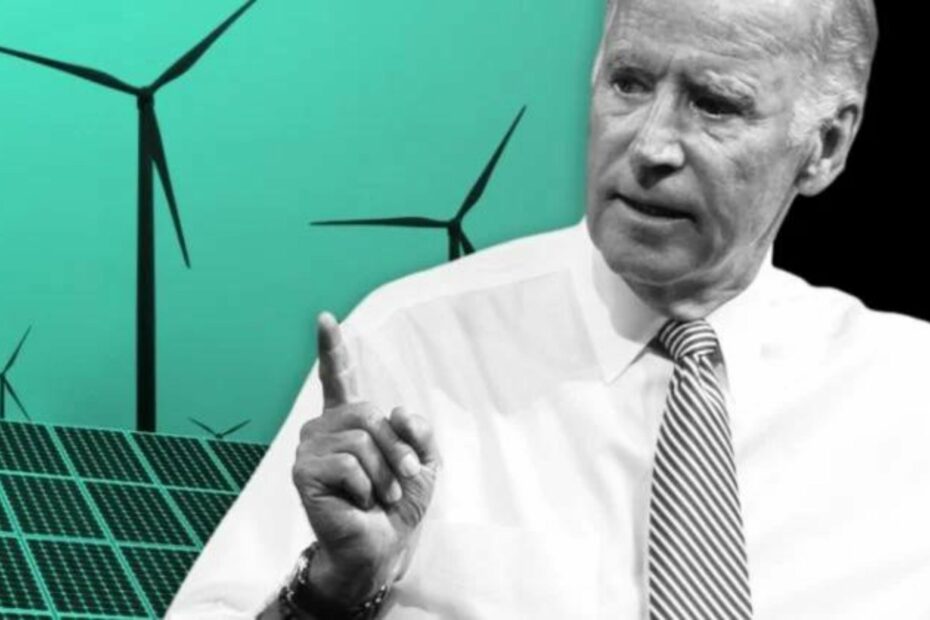Last updated on April 25th, 2023 at 08:10 am
Introduction
Joe Biden’s energy policy focuses on transitioning the United States to a clean energy economy that creates jobs, reduces carbon emissions, and enhances the country’s energy security. He has set a goal of achieving a 100% clean energy economy and net-zero emissions by 2050. To achieve this goal, Biden has proposed investing in infrastructure, research and development, and clean energy technologies. He also plans to rejoin the Paris Agreement, promote energy efficiency, and accelerate the deployment of renewable energy, including wind, solar, and geothermal energy. Biden’s energy policy emphasizes the need for a just transition, which includes providing support for workers and communities impacted by the shift away from fossil fuels. Overall, the policy aims to tackle climate change while ensuring that the United States remains competitive in the global economy.
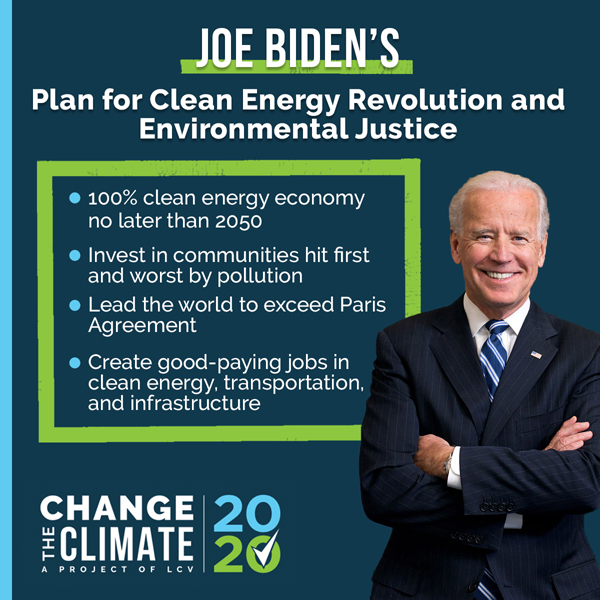
The Joe Biden administration has passed a budget that aims to build on the historic progress made towards advancing clean energy, investing in climate science, strengthening resilience, advancing environmental justice, and doubling down on America’s global climate leadership. The President’s Budget allocates a total of $52.2 billion in discretionary budget authority to tackle the climate crisis, which is $10.9 billion more than FY 2023, representing an increase of nearly 26 percent.
Transition to Clean Energy Sources
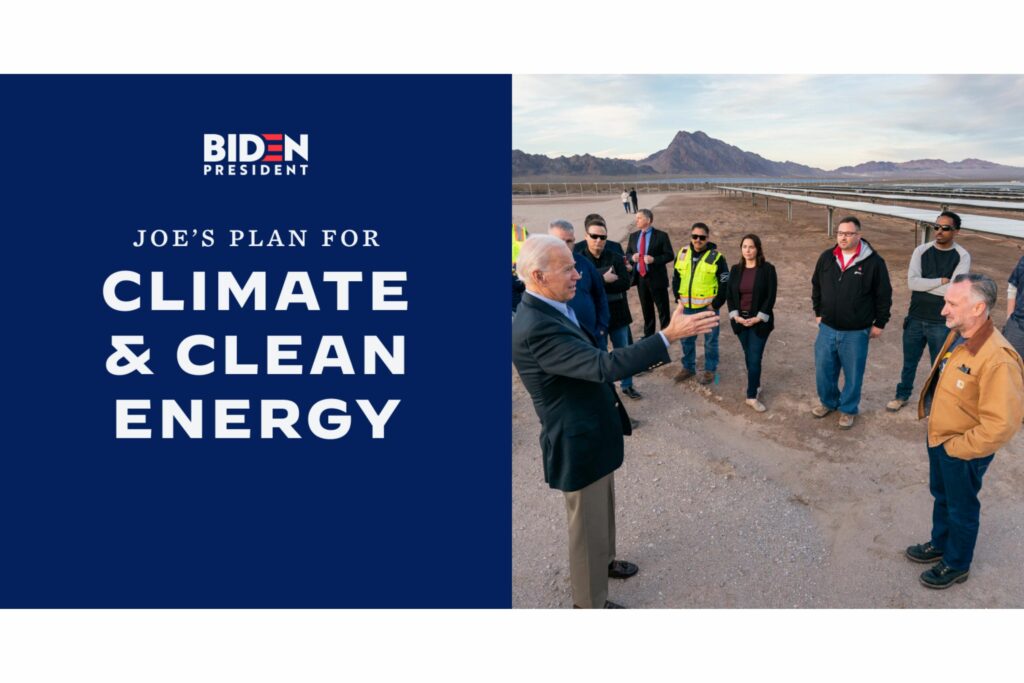
President Joe Biden’s recent State of the Union Address, where he highlighted the progress made in transitioning to clean energy. The following are five notable mentions and milestones from his speech:
- The Inflation Reduction Act, which President Biden describes as the most significant investment in climate change ever, is making clean energy technology and upgrades more accessible to Americans than ever before. The law is actively lowering utility bills, creating jobs, and propelling the world toward a clean energy future.
- President Biden emphasized the need to sustainably rebuild the infrastructure and power grids that were destroyed in recent natural disasters in Puerto Rico, Florida, and other communities. His Administration is making clean energy investments to ensure that infrastructure can withstand and prevent future environmental disasters.
- The Biden Administration’s commitment to creating a clean energy infrastructure includes building a national network of electric vehicle (EV) chargers. President Biden set a goal of constructing 500,000 EV chargers across the country by 2030.
- Americans are saving money as they make clean energy purchases and investments thanks to the Inflation Reduction Act. President Biden is committed to delivering savings to American families while ensuring they contribute to our clean energy economy and infrastructure. Tax credits for EV and clean energy appliance purchases are enabling people to save energy and money simultaneously.
- The President stressed that the climate crisis affects everyone, regardless of political affiliation. The journey to a sustainable future requires clean energy investments and innovations, and the Biden Administration and the American people have made historic, bipartisan leaps forward in this regard. America is just getting started, and the future is now.
Investment in Infrastructure
The energy and utilities industry has a significant opportunity to accelerate its grid modernization and clean energy initiatives through the funding allocated in the Infrastructure Investment and Jobs Act, signed by President Joe Biden on November 15th, 2021. This bipartisan infrastructure bill has allocated about $550 billion in new spending, with a total of $65 billion specifically earmarked for upgrading the national power infrastructure.
The funding will be directed towards initiatives focused on reducing carbon emissions, including the construction of thousands of miles of new transmission lines required for the expansion of renewables and clean energy. It will also support the development, demonstration, and deployment of cutting-edge clean energy technologies to facilitate the industry’s transition to a zero-emission economy. Efforts aimed at cleaning up Superfund and Brownfield sites, reclaiming abandoned mine land, and capping orphaned gas wells are also eligible for funding under this bill.
The $65 billion allocated for grid infrastructure and resiliency includes $23 billion to enhance the resiliency of the power infrastructure and invest in renewable energy, $21.5 billion to develop clean energy demonstrations and research hubs, $9 billion to enhance manufacturing facilities and projects, and $5 billion to boost energy efficiency and clean energy production.
The funding for this bill will primarily be channeled through the Department of Energy and the Department of Transportation.
Impact on Fossil Fuel Industry
The Biden administration has presented a tax plan to Congress aimed at reducing fossil fuel subsidies and promoting green energy. The elimination of tax subsidies for these companies could save taxpayers $121 billion over the next decade. President Biden has set an ambitious goal of achieving a fossil fuel-free power sector by 2035 and plans to introduce legislation to Congress committing to making the grid 80% clean by 2030. Additionally, he plans to transition all federal vehicles to electric. President Biden has taken executive actions to increase renewable energy production on federal lands and water, establish the Civilian Climate Corps, and hold fossil fuel companies accountable for repairing environmental damage caused by their operations. He has also prioritized environmental justice, allocating 40% of climate investments to historically vulnerable communities and creating the White House Environmental Justice Interagency Council to address these issues.
Resistance from Republican-led States
President Joe Biden’s administration has faced resistance from Republican-led states on several energy-related topics, including climate change, fossil fuel production, and renewable energy initiatives.
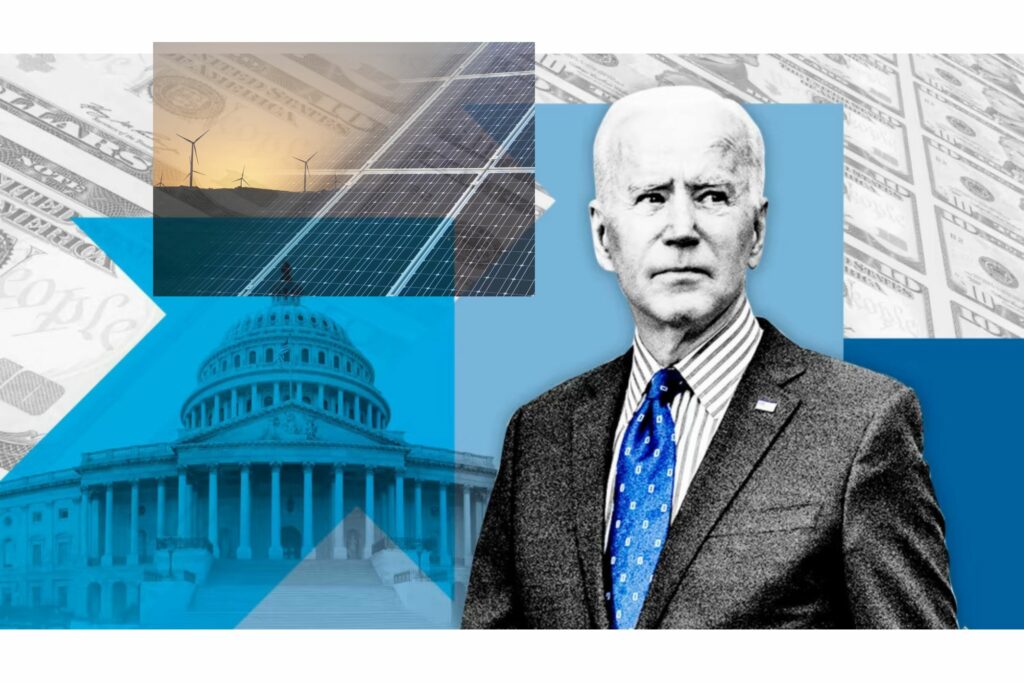
One of the most significant sources of resistance has been the Biden administration’s efforts to address climate change. The administration has taken steps to reduce greenhouse gas emissions, including rejoining the Paris Agreement, canceling the Keystone XL pipeline, and implementing new regulations on methane emissions. Republican-led states, however, have pushed back against these efforts, arguing that they will harm their economies and lead to job losses.
Another area of contention has been the Biden administration’s approach to fossil fuel production. The administration has implemented a moratorium on new oil and gas leases on federal lands and waters, which has been met with opposition from states that rely heavily on revenue from fossil fuel production. Some states have filed lawsuits challenging the moratorium, arguing that it is an overreach of federal authority.
Finally, the Biden administration has made significant investments in renewable energy initiatives, such as electric vehicle infrastructure and clean energy research and development. Republican-led states have criticized these initiatives as being too costly and unnecessary, arguing that they will not significantly reduce greenhouse gas emissions and will harm their economies.
On March 28th, 2023, House Republicans achieved a significant legislative win by passing a comprehensive energy bill. The bill pits fossil fuels against President Joe Biden’s climate change agenda, setting up a clash with Democrats. While the bill passed by a 225-204 vote with four Democrats crossing party lines, it is not expected to advance in the Democratically controlled Senate. However, Republicans can use the bill as a campaign talking point ahead of the 2024 election.
The energy bill addresses several core Republican energy priorities from the past decade, such as disapproving of President Biden’s decision to block the Keystone XL pipeline and mandating more oil and gas lease sales. The bill also makes it harder for states to block the construction of interstate pipelines that cross their borders, reflecting a broader political divide over the role of government in regulating the energy industry.
Renewable Energy and its Challenges
The Biden Administration is proposing a significant investment in clean energy research and development, with $10 billion set aside for this purpose. Additionally, $2 billion will be invested in green energy projects, and $6.5 billion will be reserved for lending to rural communities in support of green energy, power storage, and transmission projects. President Biden has also called for the doubling of energy production from offshore wind turbines by 2030.
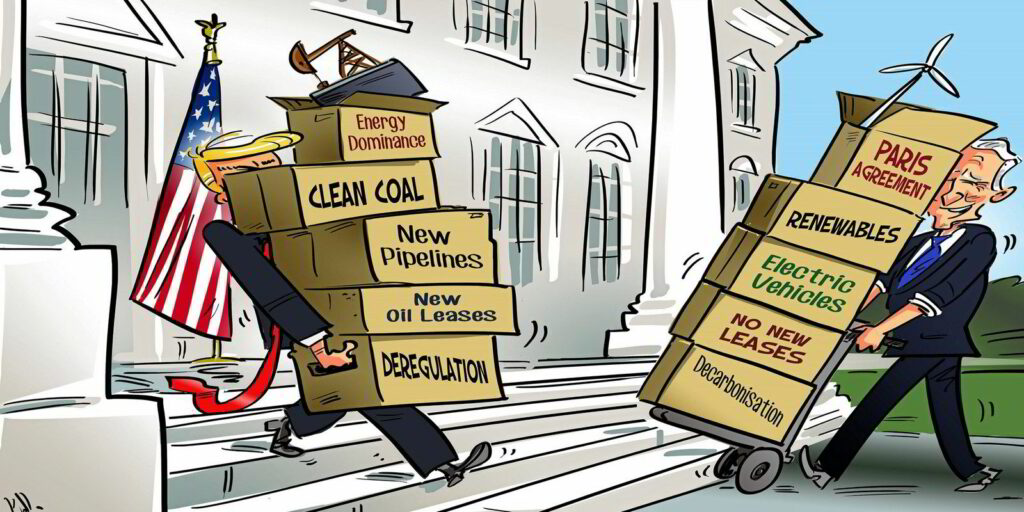
In April 2023, the Biden administration announced that it will provide $450 million in funding for clean energy demonstration projects in coal mining communities, aimed at converting current and former mines into clean energy projects. Furthermore, $16 million in funding will be allocated to the University of North Dakota and West Virginia University to create design studies for a full-scale refinery facility that can extract and separate rare-earth elements and other minerals from coal ash, acid mine drainage, and other mine waste. These minerals are crucial for electric vehicle batteries and other clean energy technologies.
The Decline of Coal Energy and its Impacts
The Biden administration is dedicating $450 million to fund clean energy projects in areas that currently or previously had coal mines, as part of their effort to address climate change. The funding will support up to five projects across the country, with at least two of them focused on solar farms. In addition to tax credits available through the 2022 Inflation Reduction Act, new bonuses will be offered to developers of clean energy projects, encouraging more investment in communities that have been negatively impacted by the decline of coal production. These actions are part of the administration’s plan to shift the U.S. economy towards renewable energy, such as wind and solar power, and away from fossil fuels that contribute to greenhouse gas emissions. The ultimate goal is to cut greenhouse gas emissions in half by 2030 and achieve a net-zero emissions economy by 2050.
Limiting Gas Pipelines and their Criticisms
The cancellation of the Keystone XL Pipeline by President Joe Biden more than a year ago is still a topic of debate, with Republican lawmakers and pundits on social media criticizing the decision. They argue that the pipeline would have given the US more energy independence and helped to counter Russian aggression in Europe. However, opponents of the pipeline, such as Jane Kleeb, founder of Bold Nebraska, argue that the pipeline would have taken years to construct in Nebraska and would have used dirty tar sands oil, which is difficult to refine. She also argues that the oil would not have been used in the US, but rather sent to other countries. Experts disagree with this claim, but the US State Department did say in 2017 that price impacts would be minimal for Americans. Gas prices may increase due to the war in Ukraine, but they could also decrease as energy demand lessens and a possible solution to the conflict occurs. The pipeline’s builder, TC Energy, has officially called off the project. President Biden’s press secretary dismissed the question of allowing for the pipeline in the future.
Offshore Wind Energy and its Challenges
Joe Biden has made offshore wind energy a priority for his administration as part of his broader plan to tackle climate change and shift the United States towards clean energy sources. In January 2021, he signed an executive order to boost the development of offshore wind projects and set a goal of installing 30 gigawatts of offshore wind energy by 2030.
Offshore wind energy presents several challenges, including technical, regulatory, and environmental hurdles. Some of the main challenges include:
High cost:
Offshore wind farms are more expensive to build and maintain than onshore wind farms. This is partly due to the need for specialized equipment and infrastructure to withstand the harsh ocean environment.
Grid connectivity:
Offshore wind farms need to be connected to the power grid, which can be a complex and costly process, particularly for projects located far from the shore.
Environmental concerns:
Offshore wind farms can have an impact on marine life, including fish, birds, and marine mammals. There are also concerns about the potential impact on habitats and ecosystems in the surrounding area.
Regulatory challenges:
Offshore wind projects require permits and approvals from a range of federal and state agencies, which can be a lengthy and complex process.
The Biden administration aims to install 30 gigawatts of offshore wind energy by 2030 and has included funding for research, development, and deployment of offshore wind technologies and infrastructure in its budget proposal. The proposal also includes $60 million to expand offshore wind permitting activities at NOAA. The administration views offshore wind as a key component of its strategy to combat climate change, reduce greenhouse gas emissions, improve air and water quality, and create new economic opportunities for coastal communities.
“Gasoline prices are anticipated to increase due to oil cuts, posing a challenge for Biden”:
On 2nd April 2023 the Kingdom of Saudi Arabia, along with other OPEC and non-OPEC countries, will be implementing a voluntary cut of 500 thousand barrels per day from May till the end of 2023 to support the stability of the oil market. This voluntary cut is in addition to the reduction in production agreed upon at the 33rd OPEC and non-OPEC Ministerial Meeting on October 5, 2022. It is a precautionary measure to help ensure market stability.
The recent decision by OPEC+ to maintain production cuts is expected to result in a noticeable increase in gasoline prices, according to experts. President Biden, however, has downplayed the impact of the decision. Gasoline prices, which were at $3.50 per gallon on Monday, are predicted to rise by 10 to 16 cents per gallon in the coming weeks. The cuts could also contribute to further increases later in the year, warned Tom Kloza, global head of energy analysis at the Oil Price Information Service. Before the cuts, U.S. oil prices had been between $67 and $80 per barrel over the past few months. Although inflation had been slowing down, the personal consumption expenditures price index fell from January to February.
Russia has also decided to join the OPEC countries in cutting oil production, which could potentially benefit Russia in coping with the Western sanctions imposed on it following its invasion of Ukraine. However, this benefit to Russia may come at the expense of the United States. Additionally, it is worth noting that Russia’s decision to cut oil production may also lead to higher gasoline prices for drivers and potentially contribute to inflation in the United States and Europe
Bottom Line:
Joe Biden’s energy policy has several key goals that focus on combating climate change, creating jobs, and promoting sustainable energy sources.
The following are some of the highlights of his energy policy:
Achieving net-zero emissions by 2050
Biden aims to reach net-zero greenhouse gas emissions by 2050. He plans to invest in clean energy technologies, including renewable energy, energy storage, and carbon capture and storage, to reduce emissions from the electricity sector.
Rejoining the Paris Agreement
On his first day in office, Biden signed an executive order to rejoin the Paris Agreement, an international climate accord aimed at limiting global warming to well below 2 degrees Celsius.
Promoting clean energy jobs
Biden plans to create millions of clean energy jobs by investing in infrastructure, research and development, and manufacturing. He aims to build a modern and sustainable infrastructure that includes electric vehicle charging stations, public transit, and high-speed rail.
Reducing carbon emissions from transportation
Biden intends to set new standards to reduce emissions from cars, trucks, and buses. He plans to invest in electric vehicle charging infrastructure and incentivize the use of electric vehicles.
Encouraging energy-efficient buildings
Biden aims to create incentives for building owners to improve the energy efficiency of their buildings. He also plans to invest in weatherization programs to help low-income families reduce their energy bills.
Protecting public lands and waters
Biden intends to protect 30% of U.S. lands and waters by 2030. He plans to ban new oil and gas leasing on public lands and waters and establish a Civilian Climate Corps to conserve and restore public lands and waters.
